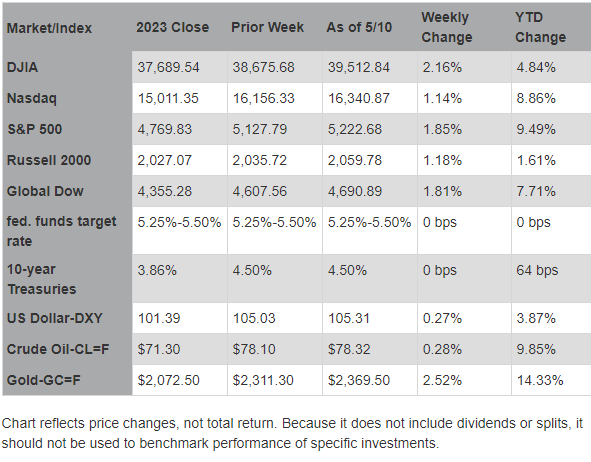Market Week: May 13, 2024
Presented by William Prentice, AWMA®, CFP®, CIMA®
KEY DATES/DATA RELEASES
5/14: Producer Price Index
5/15: Consumer Price Index, retail sales
5/16: Housing starts, import and export prices, industrial production
THE MARKETS (as of market close May 10, 2024)
The market closed last week higher. Investor sentiment was bolstered by good corporate earnings results from key megacaps. Of the 459 companies of the S&P 500 that have reported earnings, 77% beat consensus predictions. The Dow rode an eight-session winning streak, while the S&P 500 approached a record high. Among the market sectors, only consumer discretionary closed the week in the red. Utilities advanced 4.0% to lead the sectors, while financials, materials, consumer staples, communications services, and industrials outperformed. Treasury yields ended the week where they began. Crude oil prices advanced marginally. Gold prices jumped higher.
Stocks extended their rally from the previous week as each of the benchmark indexes listed here posted solid gains last Monday. The Russell 2000 and the Nasdaq gained 1.2%, the S&P 500 climbed 1.0%, the Global Dow added 0.6%, and the Dow gained 0.5%. While stocks advanced, bond yields tumbled with 10-year Treasury yields dipping to 4.48%. Crude oil prices rose for the first time in several sessions, closing at $78.68 per barrel, up $0.57. The dollar was flat, while gold prices rose 1.1%.
Last Tuesday saw stocks inch higher, but enough to extend the Dow's winning streak to five sessions and the S&P 500's streak to four straight days. The Global Dow rose 0.4% and the Russell 2000 gained 0.2% to lead the benchmark indexes. The Nasdaq edged lower by 0.1%. Ten-year Treasury yields dipped 2.6 basis points to 4.65%. Crude oil prices changed little from the day before, closing at about $78.55 per barrel. The dollar rose 0.3%, while gold prices fell 0.3%.
The Dow extended its winning streak to six straight sessions last Wednesday after gaining 0.4%. However, the remaining benchmark indexes listed here were either flat (S&P 500) or closed in the red. The Russell 2000 fell 0.5%, the Nasdaq dropped 0.2%, and the Global Dow declined 0.1%. Yields on 10-year Treasuries rose 2.9 basis points to 4.49%. Crude oil prices climbed to $79.21 per barrel. The dollar inched up 0.1%, while gold prices fell 0.3%.
Each of the benchmark indexes listed here gained ground last Thursday, with the Dow extending its winning streak to seven consecutive sessions. The Russell 2000 and the Dow led the way, gaining 0.9%, followed by the S&P 500 and the Global Dow, which added 0.5%. The Nasdaq rose 0.3%. Ten-year Treasury yields fell 4.3 basis points to 4.44%. Crude oil prices continued to advance this week, gaining $0.58 to $79.57 per barrel. The dollar slipped 0.3%, while gold prices rose 1.3%. Weekly jobless claims rose more than expected (see below), offering more hope for an interest rate cut.
Stocks were mixed last Friday, with the Global Dow (0.4%), the Dow (0.3%), and the S&P 500 (0.2%) advancing, while the Russell 2000 (-0.7%) declined, and the Nasdaq ended the day marginally lower. Yields on 10-year Treasuries rose 5.5 basis points to 4.50%. Crude oil prices fell $0.92 per barrel. The dollar inched up, while gold prices finished the week on a strong note after gaining 1.3%.
STOCK MARKET INDEXES

LAST WEEK'S ECONOMIC NEWS
- The monthly Treasury statement for April showed a surplus of $210.0 billion. The impact of large tax deposits resulted in receipts of $776.0 billion, reduced by $567.0 billion in outlays, which yielded the surplus. The total budget deficit through the seven months of the fiscal year was $855.0 billion. Over the same period last fiscal year, the deficit sat at $925.0 billion.
- The national average retail price for regular gasoline was $3.643 per gallon on May 6, $0.010 per gallon below the prior week's price but $0.110 per gallon more than a year ago. Also, as of May 6, the East Coast price rose $0.009 to $3.549 per gallon; the Midwest price dipped $0.057 to $3.396 per gallon; the Gulf Coast price increased $0.052 to $3.244 per gallon; the Rocky Mountain price advanced $0.037 to $3.463 per gallon; and the West Coast price decreased $0.042 to $4.754 per gallon.
- For the week ended May 4, there were 231,000 new claims for unemployment insurance, an increase of 22,000 from the previous week's level, which was revised up by 1,000. This is the highest number of weekly claims for unemployment benefits since August 2023. According to the Department of Labor, the advance rate for insured unemployment claims for the week ended April 27 was 1.2%, unchanged from the previous week's rate. The advance number of those receiving unemployment insurance benefits during the week ended April 27 was 1,785,000, an increase of 17,000 from the previous week's level, which was revised down by 6,000. States and territories with the highest insured unemployment rates for the week ended April 20 were in New Jersey (2.4%), California (2.3%), Rhode Island (2.2%), Massachusetts (1.9%), Illinois (1.7%), Minnesota (1.7%), New York (1.7%), Washington (1.7%), Nevada (1.6%), Alaska (1.5%), Connecticut (1.5%), and Pennsylvania (1.5%). The largest increases in initial claims for unemployment insurance for the week ended April 27 were in Iowa (+1,452), Illinois (+1,227), New Hampshire (+488), Ohio (+340), and Michigan (+330), while the largest decreases were in California (-5,083), Massachusetts (-3,306), Oregon (-1,729), Rhode Island (-1,626), and Connecticut (-1,409).
Inflation data is in the news this week with the release of the Consumer Price Index for April. Inflation has run hotter than expected over the past few months, raising concerns that the Federal Reserve may hike interest rates higher. However, statements from Fed officials seem to indicate that another rate increase is not in the offing. However, unless inflation reverses course, it is likely that the Fed will maintain the federal funds rate for longer than most had hoped.
Data sources: Economic: Based on data from U.S. Bureau of Labor Statistics (unemployment, inflation); U.S. Department of Commerce (GDP, corporate profits, retail sales, housing); S&P/Case-Shiller 20-City Composite Index (home prices); Institute for Supply Management (manufacturing/services). Performance: Based on data reported in WSJ Market Data Center (indexes); U.S. Treasury (Treasury yields); U.S. Energy Information Administration/Bloomberg.com Market Data (oil spot price, WTI, Cushing, OK); www.goldprice.org (spot gold/silver); Oanda/FX Street (currency exchange rates).
News items are based on reports from multiple commonly available international news sources (i.e., wire services) and are independently verified when necessary with secondary sources such as government agencies, corporate press releases, or trade organizations. All information is based on sources deemed reliable, but no warranty or guarantee is made as to its accuracy or completeness. Neither the information nor any opinion expressed herein constitutes a solicitation for the purchase or sale of any securities, and should not be relied on as financial advice. Forecasts are based on current conditions, subject to change, and may not come to pass. U.S. Treasury securities are guaranteed by the federal government as to the timely payment of principal and interest. The principal value of Treasury securities and other bonds fluctuates with market conditions. Bonds are subject to inflation, interest-rate, and credit risks. As interest rates rise, bond prices typically fall. A bond sold or redeemed prior to maturity may be subject to loss. Past performance is no guarantee of future results. All investing involves risk, including the potential loss of principal, and there can be no guarantee that any investing strategy will be successful.
The Dow Jones Industrial Average (DJIA) is a price-weighted index composed of 30 widely traded blue-chip U.S. common stocks. The S&P 500 is a market-cap weighted index composed of the common stocks of 500 largest, publicly traded companies in leading industries of the U.S. economy. The NASDAQ Composite Index is a market-value weighted index of all common stocks listed on the NASDAQ stock exchange. The Russell 2000 is a market-cap weighted index composed of 2,000 U.S. small-cap common stocks. The Global Dow is an equally weighted index of 150 widely traded blue-chip common stocks worldwide. The U.S. Dollar Index is a geometrically weighted index of the value of the U.S. dollar relative to six foreign currencies. Market indexes listed are unmanaged and are not available for direct investment.
Prepared by Broadridge Advisor Solutions. © 2024 Broadridge Financial Services, Inc.


